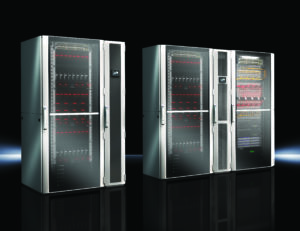Heat is not your friend. At least that’s the case when discussing industrial enclosures and why heat dissipation is such a critical concept to ensure the operational functionality and efficiency of the components housed within the enclosure.
Aside from foreign contaminants such as oil-contaminated air and/or humid ambient air, dust, or other corrosive airborne agents, heat accumulation is the major cause of breakdowns or disruptions within enclosures and why plant engineers and maintenance managers must keep high-density thermal loads at top of mind.
Heat dissipation is an important element with any industrial enclosure for a number of reasons, but primarily because high temperatures can severely and significantly decrease the lifespan of panels or electronics in the enclosure as well as the enclosure itself. Some of the consequences of heat build-up within an enclosure include:
- De-rated power performance
- Trip faults and fluctuations in circuits
- Intermittent system failures
- Increased production downtime
- Delayed shipments
- Component replacement costs
- Customer dissatisfaction
Aside from these production and logistical challenges, improper heat dissipation also results in loss of revenue and an increase in energy consumption and costs.
According to the Rocky Mountain Institute, a nonprofit efficiency-focused research organization, in industrial settings, “there are abundant opportunities to save… 60 percent of the energy and cost[s] in areas such as heating [and] cooling.”
If one is looking to understand why heat dissipation with industrial enclosures is so important, one must also understand the methods of heat dissipation in play. With industrial enclosures, there are 2 main types of heat dissipation or transfer:
- Thermal conduction
- Convection
The introduction of heat conduction or convection depends on whether the enclosure is open (air-permeable) or closed (air-tight). With an open enclosure, heat can be dissipated from the enclosure by means of air circulation, i.e. thermal conduction, from inside to outside. If the enclosure has to remain closed, the heat can only be dissipated via the enclosure walls, i.e. through convection.
While advancements in both the electronic components inside an enclosure and the ability to monitor heat dissipation and/or accumulation levels via remote and digital means has increased during the last 10 years, the types of enclosures and environments these enclosures operate in has also diversified, resulting in new factors to consider with heat dissipation.
Some of these factors include:
- Enclosure construction materials and finishes
- Orientation of the enclosure, as vertically and horizontally-mounted enclosures will have different degrees of heat dissipation efficiency
- The materials or composition of the structure the enclosure is mounted to, as these structures will also impact overall heat dissipation
Understanding the method of heat dissipation relative to the elements of the enclosure is key in determining the right climate control solution. If left unchecked, small malfunctions that may be the first sign of overheating can lead to sudden, catastrophic failures. A thorough review of an enclosure’s heat dissipation capacity should be an essential component of an effective climate control system.
Rittal leads the way in climate control solutions.
Learn more in our climate control whitepaper.

